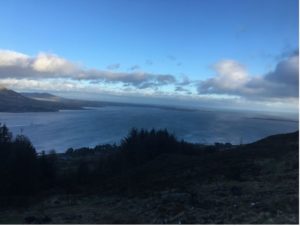
Slieve Foye overlooks Carlingford Lough on the southern side of the border between Northern Ireland and the Republic of Ireland. Image by Heather Baier. Carlingford, Ireland, 2018.
On February 14, 2015, while most of his friends were carrying bouquets of roses and Belgian chocolates, Shay O’Daleigh donned a pair of plastic gloves and arrived on the shore of Carlingford Lough with a trash bag in hand, ready for his first date with the waterway. Before the night was through, he and others with the newly formed environmental organization, Love Your Lough, pledged to commit themselves to defending the Lough’s habitats and natural beauty. Now, only two years later, they are worried about fulfilling that promise–but not for any lack of desire on their part.
The Carlingford Lough lies directly on the border between the Republic of Ireland and Northern Ireland. This means that it could be dramatically impacted by the tug-of-war between the European Union and the United Kingdom, O’Daleigh says. In particular, environmental protections long secured by the European Union may be at risk, he says.
“Brexit is a major concern for us,” O’Daleigh says, referring to the impending separation of the United Kingdom, including Northern Ireland, from the European Union.
An International Game of Tug-Of-War
Carlingford Lough is surrounded on almost all sides by communities that utilize the lough for its many resources. A source of food, tourism and activity for its neighbors, the lough is a vital part of the surrounding towns.
Lough Foyle, situated in Londonderry, Northern Ireland, stands in a very similar situation to that of Carlingford Lough, split about equally between the Republic of Ireland and the U.K.
For years, officials from the Republic of Ireland fought with those from Northern Ireland for control over the loughs, says Michael Ewing, coordinator of Ireland’s Environmental Pillar, an organization comprised of environmental groups throughout Ireland. But in 1998 under the Good Friday Agreement, the British and Irish governments agreed to create the bilateral Loughs Agency, to advocate for wildlife and ensure that both sides of the border have equal responsibility for the waterway ecosystems.
Ewing says he hopes the agency will keep operating because it is the main mechanism by which cooperation and control over the Loughs’ resources is facilitated. But he also notes that the Loughs Agency’s success in regulating the cross-border loughs is due to the way it was funded. And with half of its funds coming from the European Union there are questions about its long-term sustainability post Brexit, Ewing says.
The Carlingford Lough is designated as both a Special Area of Conservation and a Special Protection Area, which gives legal mechanisms to local governments to regulate industry and building in the areas. This ensures that when a new development that could threaten a protected habitat is proposed, local communities have the grounds to reject it. These statuses are regulated by the EU’s Habitats and Bird’s Directives, and they stand to be lost after Brexit.
Even the signs along the dock in Carlingford, showing obvious signs of age with murky covers scratched from years of visitors, boast about the statuses in place to protect the habitats that make the Carlingford Lough the oasis it is.
Escaping into the Irish Sea, water from the Carlingford Lough carries with it species of algae, sponges, starfish and sea anemone. Bordering the Lough is ancient Irish Oak to the north and Slieve Foy with its dozens of grazing sheep to the south.
Ewing said that Brexit poses a direct threat to the environmental protection statuses laid out by the Habitats and Bird Directives.
“The [Carlingford] Lough is a protected site under European law,” said Ewing. “[It is] a place being protected because of its importance as a place of nature so when the U.K. withdraws from the European Union that won’t apply anymore to their part of the site, so the protection will change or disappear.”
The policy makers themselves have the deciding vote in the fate of U.K. environmental law, but organizations like Love Your Lough that work day in and day out to ensure that their habitats are protected, are kept out of the loop in the decision-making process.
While in the past most groups have been able to agree about the protections of different species, cases such as the hazardous waste facility prove that changes on one side of the border could drastically affect the other.
Under consideration now is a new nursing home facility on the shores of the Lough and the foothills of the Rostrevor forest in Rostrevor, Northern Ireland. The forest, composed of ancient Irish oak over a century old, faces an uncertain future if the nursing home is approved and the developers choose to place it in forested land.
A History of Neglect and Exploitation
While the Carlingford Lough faces many potential threats in the event of a hard-border decision or a loosening of environmental regulations after Brexit, it has faced previous struggles that highlight the need for cross-border cooperation and communication.
O’Daleigh said just recently there was a proposal to build a hazardous waste facility on the shores of the Lough.
The company that submitted the application, Re-Gen Waste Ltd, held a forum for community input, which was announced in late June 2017. One of the arguments that led to the withdrawal of the application was the waste facility’s proposed location being within 1 km of a special area of conservation and a special protection area. Both of these designations are regulated by the EU and are threatened by Brexit.
“There was a proposed hazardous application made to have a hazardous waste facility right in the water edge in Warrenpoint Port,” O’Daleigh said, “The application has been shelved but only for the likes of little groups like ourselves and the No Toxic Lough group and other small community groups.”
A source of concern for the community was the interest of council members in the waste facility and particularly those on the northern side of the border, whose environmental policies are still under consideration.
Carlingford Lough’s protected designations by the E.U. and efforts by community members helped the Love Your Lough and No Toxic Lough group overthrow the application for a waste facility in Warrenpoint because of its proximity to the Carlingford Lough’s Special Area of Conservation.
Re-Gen withdrew its application for the waste facility, announced in a press release in mid-July 2017. “…We have seriously considered their views along with those of the wider community on both sides of the lough and despite our confidence that the facility would not have had in fact any negative impact we have concluded that we do not wish to cause them any further distress or concern,” Managing Director of Re-Gen Joseph Doherty said.
It was from this issue that the Love Your Lough group became actively engaged in environmental activism around the Carlingford Lough. Though it doesn’t often engage in politics, the group engaged other organizations like No Toxic Lough and eventually grew their own membership and range of activities.
“It gave us the drive to say well if the council and the authorities aren’t going to look after the lough, the community is going to have to because Carlingford Lough belongs to all of us, not just some of us,” O’Daleigh said.
A Home to All
A 7-euro ticket and a 30-minute ride on Bus Éireann from the nearby town of Dundalk will land a traveler in the lough-side town of Carlingford, Ireland. To the east are the Cooley mountains, the small peaks blanketed in fog, and the rolling hills of Slieve Foye in various shades of brown and green. The waves lap at ancient stone walls.
A short walk from the bus stop, a dock leads out into the water, toward an inlet to the Irish Sea. Lining the sides of the dock and soaking in the water splashing over the sides of the stone railings, wet signs boast about the marine life the water holds.
Blue Mussells, Pacific Oysters and Shellfish are among the many species that have made their homes in the Lough.
The Love Your Lough group, composed entirely of volunteers who do the majority of the grunt work in preserving and cleaning up the Lough, work hard to preserve the critters these signs describe – and also to involve the community in their efforts.
“We came about starting to do the clean-ups ourselves and started doing beach cleans here there, everywhere around the lough not one particular place but just where it needed and just to bring awareness about the state of the lough,” O’Daleigh said. “These beach cleans were a major success and people came from everywhere but it showed us that there was a great will from the community, the ordinary people and wanting to look after the environment and protect the wildlife and the nature.”
O’Daleigh said the group encourages people to join by promoting environmental activism as a fun and exciting experience.
“We want to spread through fun and laugh and good faith, said O’Daleigh. “We’ve been promoting little two-minute beach cleans. We’ve been tree planting, we’ve had a couple of little events called Take a Walk on the Wild Side where we show the wildlife and the sea life that’s in the lough.”
In the hopes of spreading the message of a healthy environment to future generations, the group invites schools in the nearby areas to help out in clean-up efforts. However the Brexit negotiations turn out, O’Daleigh said the Love Your Lough group has never and will never choose sides.
“We made sure we weren’t north, we weren’t south, we were from the east coast of Ireland,” O’Daleigh said. “And we always said the nature had no borders and neither does the lough or the environment and we just see the nature and the wildlife and treat it as it is… We don’t use words like cross-border or cross-community and we don’t use different sections because we just look at it as we’re all a community we’re all one people and it’s the same story for everyone here. We all have to think we’re all together and the Lough is for all of us not just for one of us.”
Waiting in Carlingford for Bus Éireann to come around the corner and take them back home, travelers stand with their backs to the Lough, no longer able to see the Cooley Mountains or the grazing sheep in the night. They can feel the cool wind coming off the water from all sides, mixing together in a single pillow around them as they wait
This Story was originally published in Pulitzer Center (13 March 2018) at pulitzercenter.org/reporting/loughed-away-brexit-raises-concerns-about-environmental-protections The Story is also a part of William & Mary Sharp 2017 -2018 Reporting Projects.
The Pulitzer Center on Crisis Reporting is an innovative award-winning non-profit journalism organization dedicated to supporting in-depth engagement with underreported global affairs through our sponsorship of quality international journalism across all media platforms and a unique program of outreach and education to schools and universities.
Heather Baier is an undergraduate student at the College of William and Mary, class of 2020, pursuing a degree in data science. On campus she is Variety Editor of William and Mary’s student newspaper The Flat Hat; a member of MANOS, a community development and public health project in Nicaragua; and a researcher with GeoQuery. She plans to pursue a career in data journalism and computer-assisted reporting.



No comments yet, add your own below